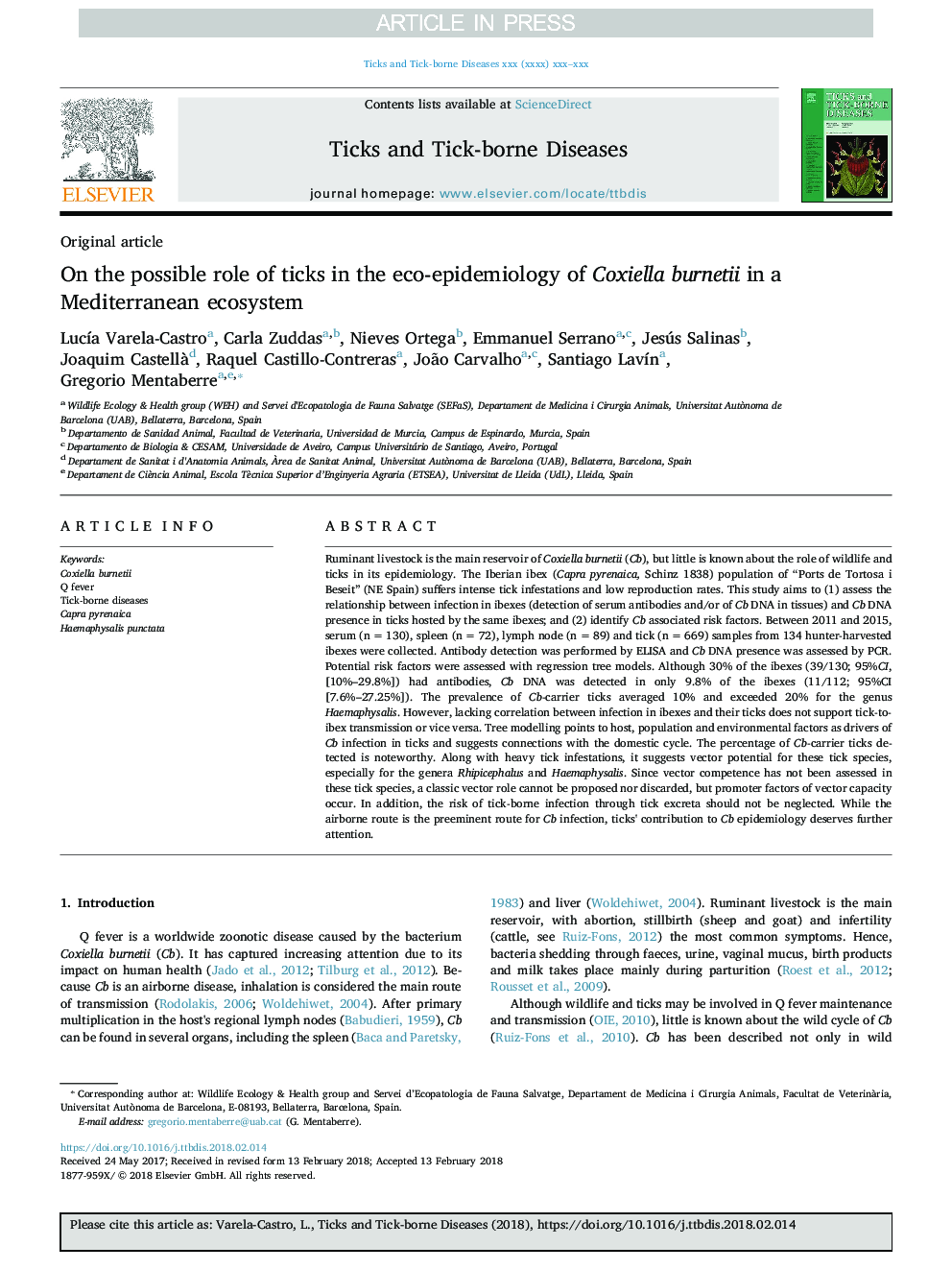| کد مقاله | کد نشریه | سال انتشار | مقاله انگلیسی | نسخه تمام متن |
|---|---|---|---|---|
| 8507330 | 1555961 | 2018 | 8 صفحه PDF | دانلود رایگان |
عنوان انگلیسی مقاله ISI
On the possible role of ticks in the eco-epidemiology of Coxiella burnetii in a Mediterranean ecosystem
دانلود مقاله + سفارش ترجمه
دانلود مقاله ISI انگلیسی
رایگان برای ایرانیان
کلمات کلیدی
موضوعات مرتبط
علوم زیستی و بیوفناوری
علوم کشاورزی و بیولوژیک
علوم دامی و جانورشناسی
پیش نمایش صفحه اول مقاله

چکیده انگلیسی
Ruminant livestock is the main reservoir of Coxiella burnetii (Cb), but little is known about the role of wildlife and ticks in its epidemiology. The Iberian ibex (Capra pyrenaica, Schinz 1838) population of “Ports de Tortosa i Beseit” (NE Spain) suffers intense tick infestations and low reproduction rates. This study aims to (1) assess the relationship between infection in ibexes (detection of serum antibodies and/or of Cb DNA in tissues) and Cb DNA presence in ticks hosted by the same ibexes; and (2) identify Cb associated risk factors. Between 2011 and 2015, serum (nâ¯=â¯130), spleen (nâ¯=â¯72), lymph node (nâ¯=â¯89) and tick (nâ¯=â¯669) samples from 134 hunter-harvested ibexes were collected. Antibody detection was performed by ELISA and Cb DNA presence was assessed by PCR. Potential risk factors were assessed with regression tree models. Although 30% of the ibexes (39/130; 95%CI, [10%-29.8%]) had antibodies, Cb DNA was detected in only 9.8% of the ibexes (11/112; 95%CI [7.6%-27.25%]). The prevalence of Cb-carrier ticks averaged 10% and exceeded 20% for the genus Haemaphysalis. However, lacking correlation between infection in ibexes and their ticks does not support tick-to-ibex transmission or vice versa. Tree modelling points to host, population and environmental factors as drivers of Cb infection in ticks and suggests connections with the domestic cycle. The percentage of Cb-carrier ticks detected is noteworthy. Along with heavy tick infestations, it suggests vector potential for these tick species, especially for the genera Rhipicephalus and Haemaphysalis. Since vector competence has not been assessed in these tick species, a classic vector role cannot be proposed nor discarded, but promoter factors of vector capacity occur. In addition, the risk of tick-borne infection through tick excreta should not be neglected. While the airborne route is the preeminent route for Cb infection, ticks' contribution to Cb epidemiology deserves further attention.
ناشر
Database: Elsevier - ScienceDirect (ساینس دایرکت)
Journal: Ticks and Tick-borne Diseases - Volume 9, Issue 3, March 2018, Pages 687-694
Journal: Ticks and Tick-borne Diseases - Volume 9, Issue 3, March 2018, Pages 687-694
نویسندگان
LucÃa Varela-Castro, Carla Zuddas, Nieves Ortega, Emmanuel Serrano, Jesús Salinas, Joaquim Castellà , Raquel Castillo-Contreras, João Carvalho, Santiago LavÃn, Gregorio Mentaberre,